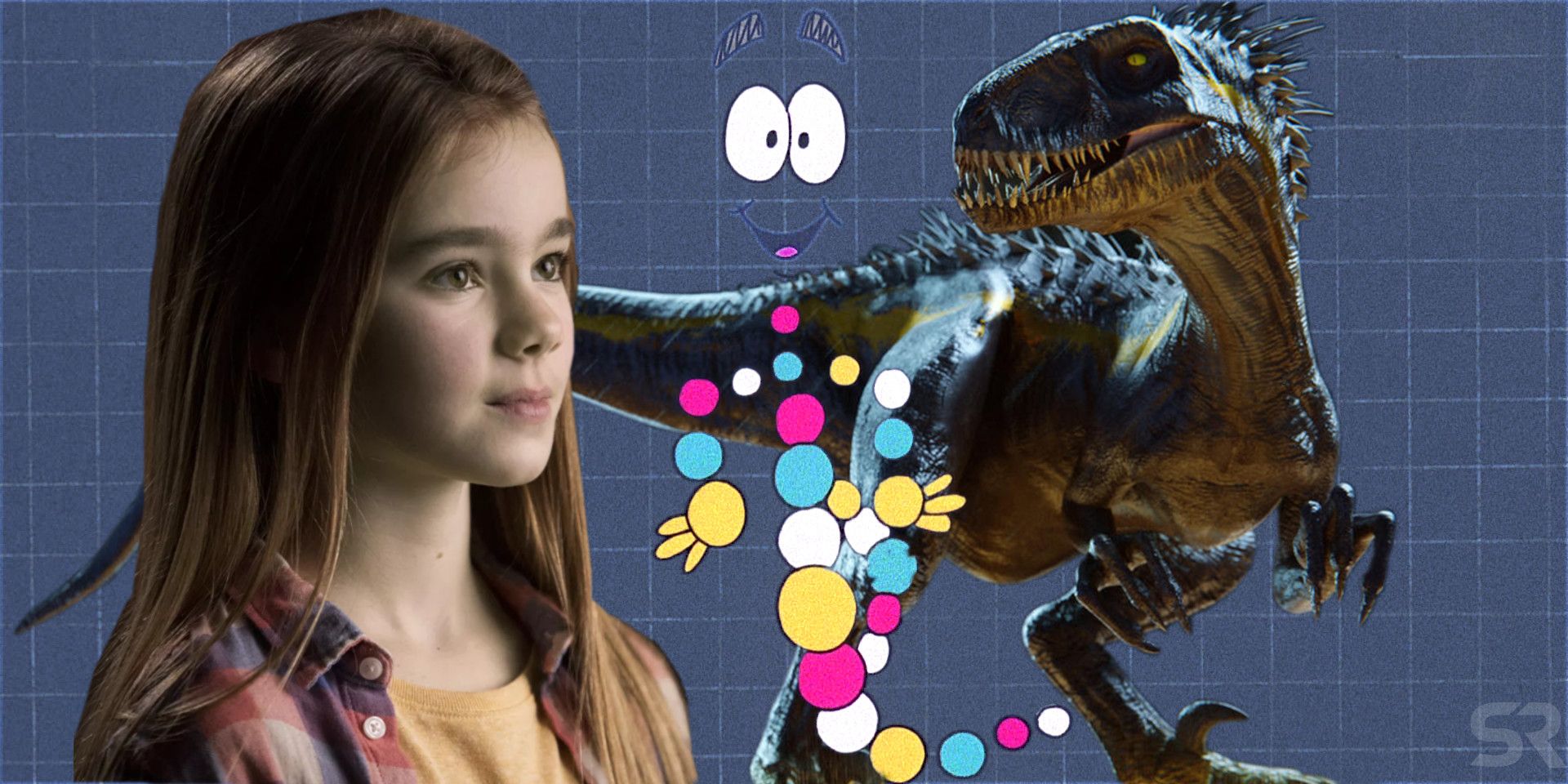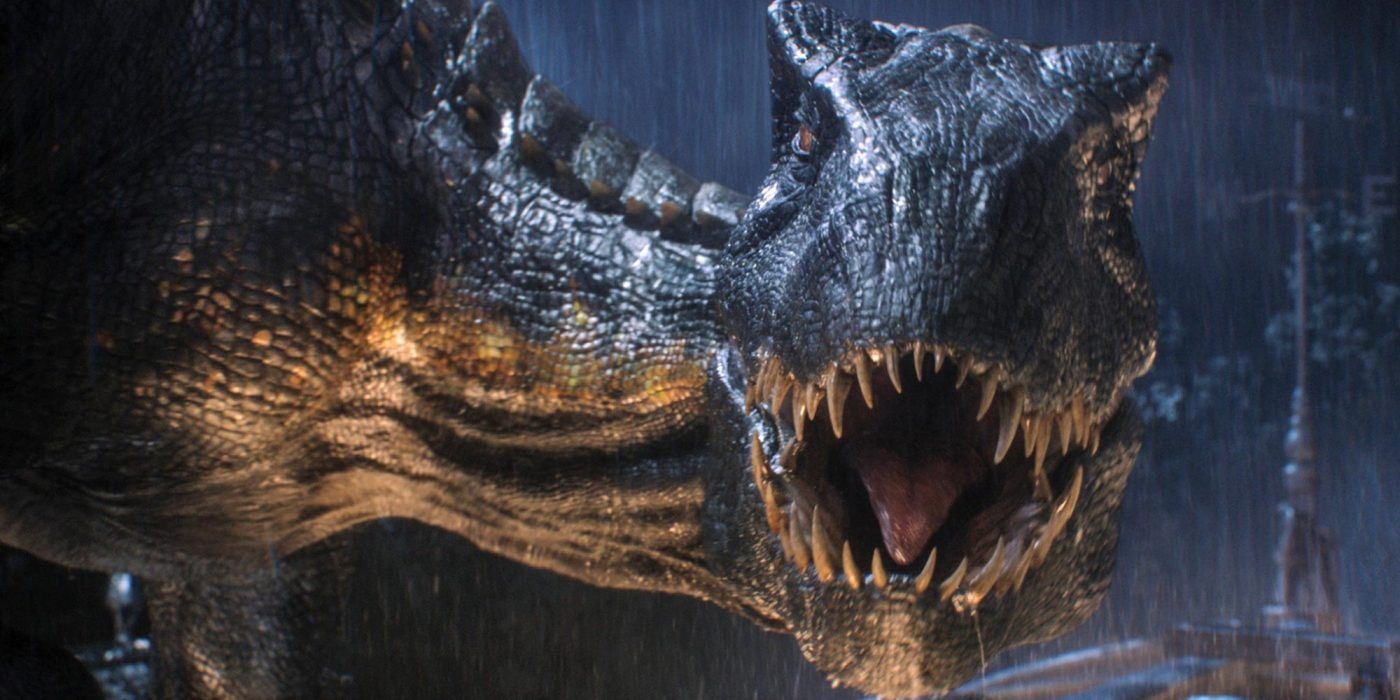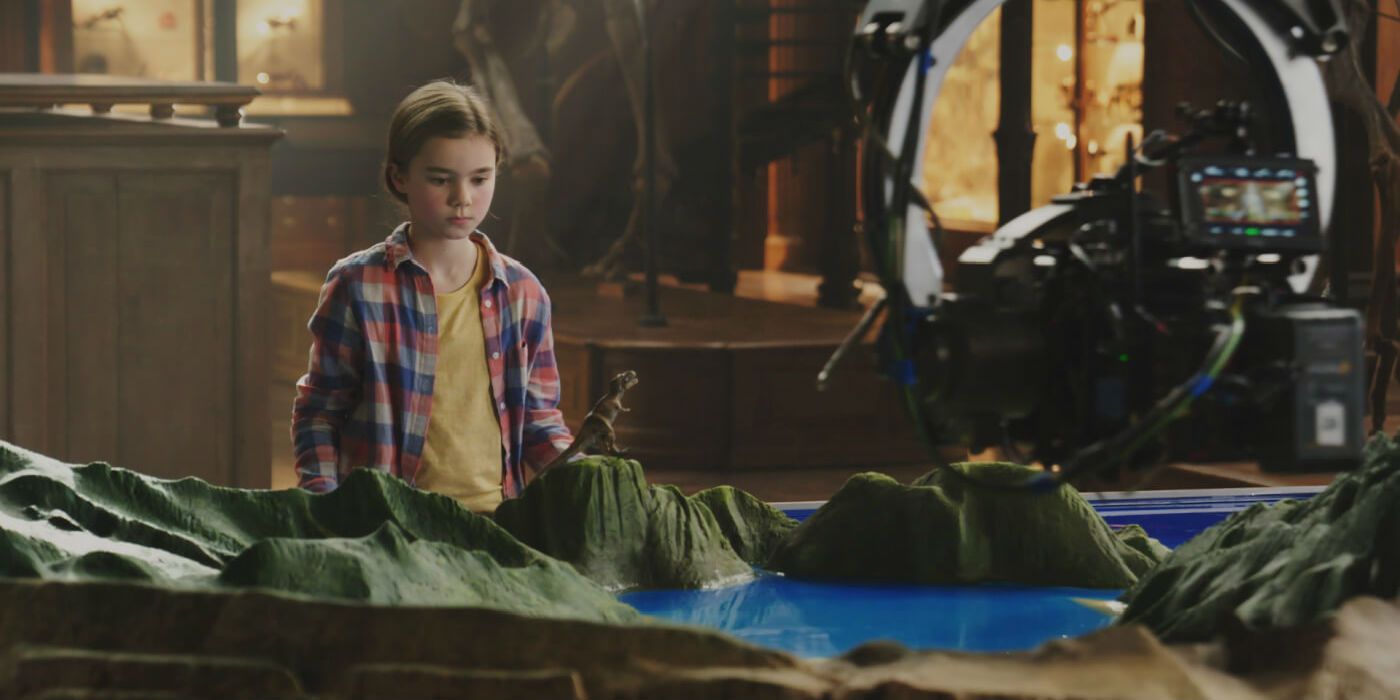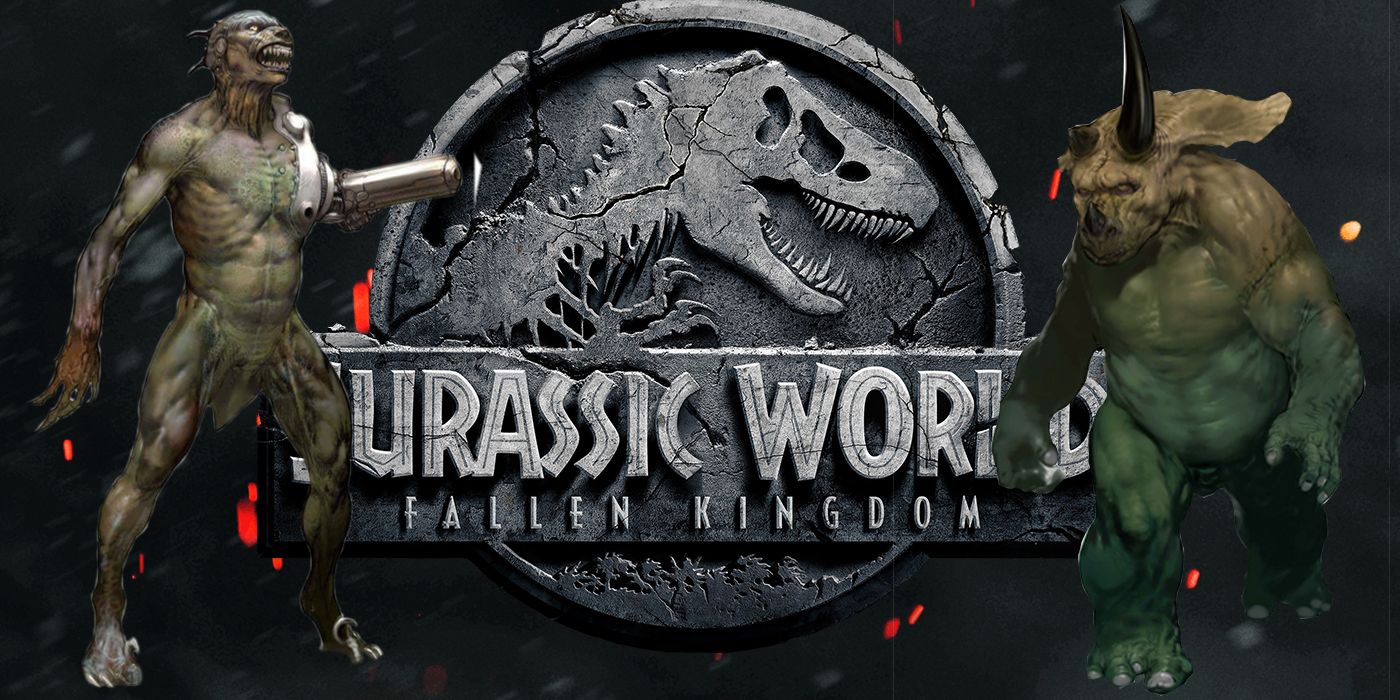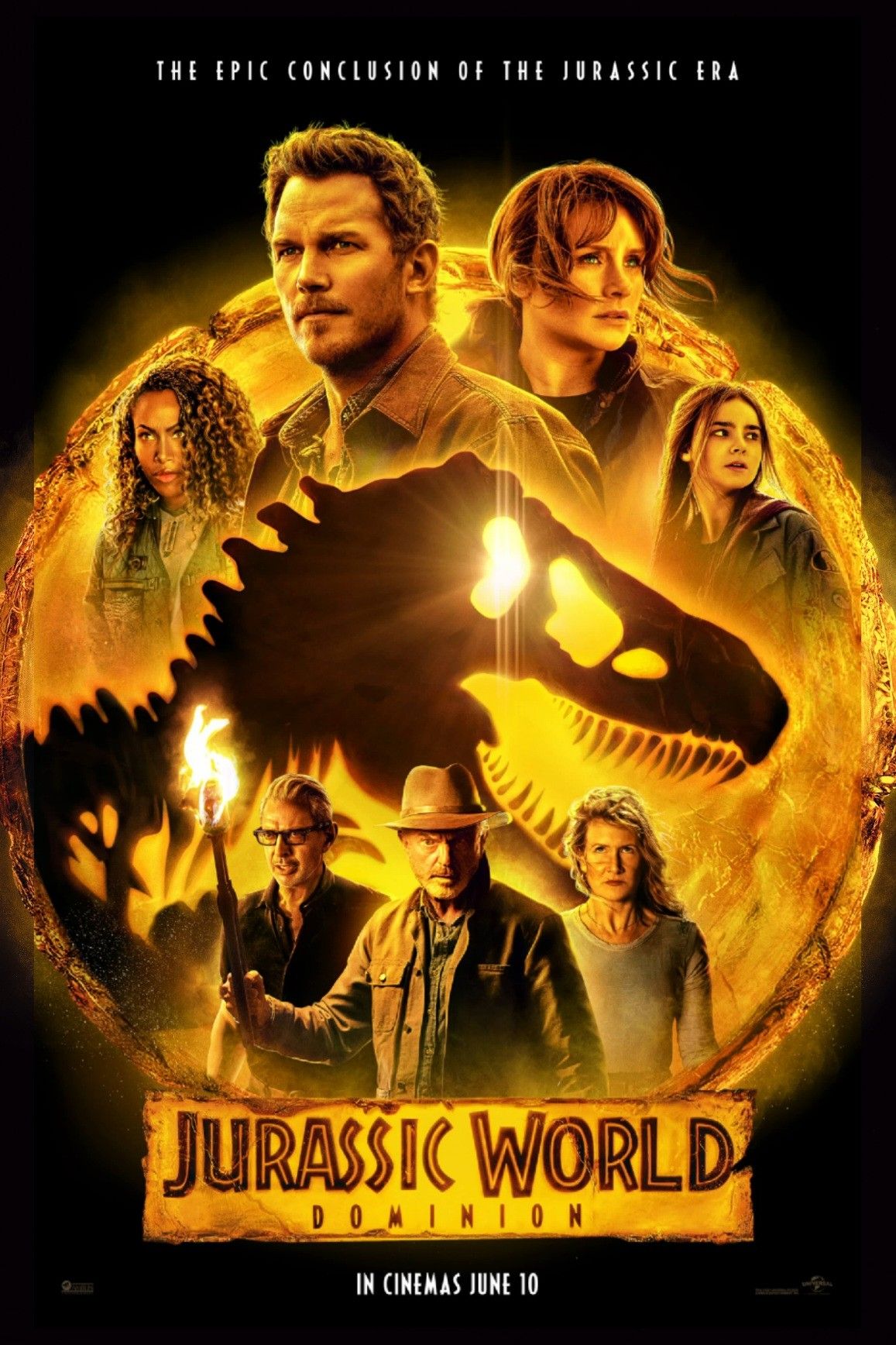Warning: Spoilers for Jurassic World: Fallen Kingdom.
The specifics of the Indoraptor's hybrid DNA weren't specified in Jurassic World: Fallen Kingdom, but there's a lot of evidence it was part human. Several hints about its genetic makeup are present throughout the movie, and aside from its obvious Velociraptor DNA, its other dominant gene proves that the Jurassic franchise isn't afraid of outdoing itself in the realm of experimental engineering.
In Jurassic World: Fallen Kingdom, the Indoraptor doesn't officially show up until the movie's final act, but its presence is felt from the get-go. With genetic engineering being the most obvious theme in the Jurassic franchise, Fallen Kingdom attempts to showcase how far humans are willing to go in order to push the boundaries of science. As if cloning dinosaurs didn't conjure enough of a "wow" factor on its own, the lengths at which scientists like Dr. Henry Wu (B.D. Wong) go to prove that unchecked human potential is actually more unnerving than inspiring. However, the Indoraptor's conception may prove to be the most heinous example of moral indifference in the entire Jurassic series to date.
More: Jurassic World: Fallen Kingdom's Game-Changing Ending Explained
In the original Jurassic Park, the rebirth of dinosaurs alone opened the floor for debate. Dr. Ian Malcolm's statement about how "scientists were so preoccupied with whether they could, they didn't stop to think if they should" become a connective thread throughout the series about ability and restraint, indulgence and inhibition. Now, the Indoraptor represents peak-meddling with genetic engineering, and the creature's DNA makeup elevates it from a dinosaur hybrid into a modern Frankenstein's monster - assuming this theory is correct.
- This Page: Is The Indoraptor is Part-Human?
- Page 2: Jurassic World Can Only Get Darker From Here
Theory: The Indoraptor is Part-Human
It's obvious the Indoraptor is a modified raptor based on its name and appearance. But it's stronger, smarter, and can kill on command. There's just one major element present in the Indoraptor that isn't ever officially mentioned in the movie. Despite a lack of proof in the dinosaur's physical appearance, there's reason to believe the Indoraptor is actually made up of human DNA. It's a crazy theory, but the proof is actually far more present in Fallen Kingdom than some audiences may have noticed.
During the dinosaur auction scene at Lockwood Manor, auctioneer Gunnar Eversol (Toby Jones) introduces each dinosaur with colorful detail. However, when he introduces the Indoraptor, he holds back. Aside from explaining that it's a prototype, Eversol explains that the Indoraptor was created with the DNA of the two most destructive creatures to ever walk this planet. And though the dinosaur half is easy to deduce by looking at it, the second of the two is never specified, which opens the door for a process of elimination. Considering Jurassic World: Fallen Kingdom may well be using dinosaur preservation as a backhanded criticism of humanity's approach to social unrest, climate change, and political greed, among other things, humans are definitely not the heroes in this series - not for the most part, at least. So, considering the movie's mostly unfavorable depiction of mankind, it's no wonder they'd refer to humans as one of Earth's most dangerous animals.
The Indoraptor's behavior may be another major sign of its human DNA. Its intelligence far surpasses that of a Velociraptor (playing dead, quietly opening doors) and the way it moves has noticeably human qualities (sneaking up on Maisie and grazing her hair, reaching out for Maisie when she's hiding in bed). That said, the human-esque qualities even extend to the movie's twist that - technically speaking - isn't even about dinosaurs at all.
Related: Jurassic World STILL Can’t Figure Out Who Its Villains Are
During the final act of the movie, it's revealed that Maisie (Isabella Sermon) is a clone. This aspect of the movie is clearly meant to signify the moral and ethical complexities that have been evolving throughout this entire series, but it might also serve a more specific purpose. It's proof that, yes, human genetics are being tampered with, and the proof is being hidden away along with all the other genetically-modified species at Lockwood Manor. When considering all of the hints that Maisie shares a connection with the dinosaurs, the blending of human and dinosaur DNA seems that much more likely. Maisie is seen cleverly unlocking her bedroom door (not unlike the Raptors and more specifically, the Indoraptor), mimicking Blue's mannerisms, and while she's being chased by the Indoraptor, there is a shot of her face blending in with the Indoraptor's face through a sheet of glass in what appears to be a moment of blatant symbolism.
Maisie's similarities with the dinosaurs may be solely confined to the fact that they all happen to be clones, but her role has to serve a bigger purpose. A twist just for the sake of being a twist doesn't have any substantial value, but including genetic meddling with human DNA to draw the audience's attention to a larger moral and ethical issue broadens the scope of the series' overarching themes.
Page 2 of 2: Jurassic World Can Only Get Darker From Here
Jurassic World Is Going All-In on Genetic Engineering
When Benjamin Lockwood (played by James Cromwell) is introduced in Jurassic World: Fallen Kingdom, he represents a window into the past. As John Hammond's former partner, he not only helped create the first Jurassic Park, but the first dinosaur. That said, it's revealed in Fallen Kingdom that the two had some ethical differences. It turns out that Hammond did have limits - specifically with the meddling of human DNA - and this revelation brings up the concept of uninhibited ambition, despite obvious consequences.
By the time of Fallen Kingdom, man is shown to be more aligned with playing God than being scientists. The lack of restraint showcased throughout the entire Jurassic series has hit a tipping point, not only through the weaponization and auctioning-off of dinosaurs, but in how the technology has evolved. It bypassed general ethics and dove straight into human cloning. So, given the obvious lack of restraint, as well as the theme of unlimited excess, the sky's the limit.
Related: The Biggest Unanswered Questions From Jurassic World: Fallen Kingdom
In the original Jurassic Park, Hammond repeated the line, "We've spared no expenses." And though his intentions may have been good, that line has come back to haunt his legacy. It's taken on a life of its own - void of limits, morality, and any signs of slowing down. So, seeing as the scientists in the Jurassic series continue to go all-in on genetic engineering - and not to mention are now aligned with the military to create the "perfect soldier" - it's not so much a question as to "What's stopping them?" as it is, "Where else could they possibly go?"
Jurassic World: Fallen Kingdom may have presented all the pieces necessary to know the Indoraptor's second dominant gene, but left it up to audiences to put it all together. Assuming the theory is true, it's as though co-writers Colin Trevorrow and Derek Connolly and director J.A Bayona were showing the kind of restraint that Hammond never could. For a series that has been lacking in subtlety, perhaps their most extravagant concept was the concept with which they decided to test out a new understated approach - assuming the over-the-top blow might be too extreme in this case.
Human DNA Was Always the Endgame
As absurd as it might seem, creating human-dinosaur hybrids isn't exactly untouched territory in the Jurassic franchise. Before Jurassic World ever went into development, there was a planned fourth Jurassic Park movie from screenwriters William Monaghan (The Departed) and John Styles (The Howling, Eight Men Out) that included human-dinosaur hybrids. Certain elements from their original script ended up finding their way into the Jurassic World series (i.e. a dinosaur-tamer similar to Owen Grady, an underground facility creating hybrid dinosaurs, and an active volcano), but the human/dinosaur splicing angle was altogether abandoned. Or so it seemed.
Amblin Entertainment reportedly scrapped the project once they saw concept art of humanoid dinosaurs wielding guns, and Jurassic Park IV sat in development hell until it took a cue from its own series and evolved into something more commercially accessible. So, it wasn't so much the human-dinosaur hybrids themselves that sent the original concept to an early grave, but the physical appearance of said dinosaurs. That suggests that incorporating human DNA into the dinosaurs was always part of the bigger picture. The dinosaurs in the Jurassic series have always been hybrids (this is explained in the first movie with the inclusion of frog DNA), and they've only grown more and more experimental in their genetic design. InGen has been constantly pushing boundaries, so even though the Indoraptor may not look anything like the hybrid concepts from Jurassic Park IV, that's not to say it couldn't still carry traces of human DNA. After all, given the Indoraptor is a prototype, who's to say how much human DNA Wu incorporated in the first place?
It's anyone's guess as to whether or not the Indoraptor's genetic makeup really was spliced with human DNA. Colin Trevorrow claimed that Jurassic World 3 will not incorporate hybrid dinosaurs, so that may not be a direction the franchise develops, unless Trevorrow simply said it to preserve spoilers. So, if the subtle hints in Jurassic World: Fallen Kingdom were setting up a big reveal in Jurassic World 3, Trevorrow may all-out abandon this direction altogether for the sake of a simpler, back-to-basics storyline. That said, maybe repeat viewings will help draw a clearer resolution and settle this theory once and for all.

